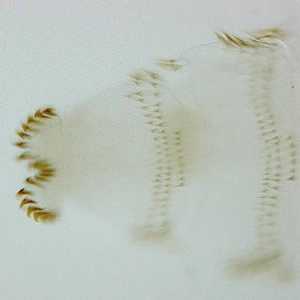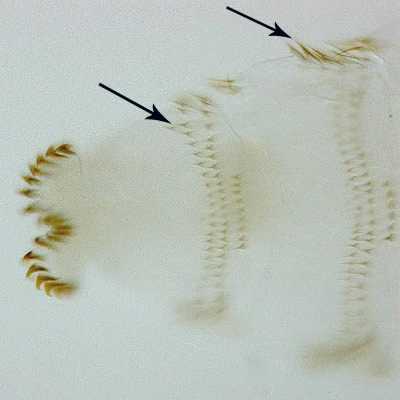
Case #152 - March, 2005
A 25-year-old male went to a local hospital complaining of a two-week history of worsening irritation of his left eye. He resides in a semi-rural area, where sheep and horses are raised, and recently returned from Samoa four weeks previous to his hospital visit. While at the hospital, he mentioned that he saw an object crawling on his conjunctiva and removed it. He could not remember any specific event that initiated these symptoms. Upon examination by slit lamp, three larvae were seen and it was noted that they moved away from the light. The larvae (Figures A-C), measuring approximately .75mm in length, were removed and sent to the laboratory for identification. What is your diagnosis? Based on what criteria?

Figure A

Figure B

Figure C
Case Answer
This was a case of myiasis caused by the first instar of the sheep bot fly, Oestrus ovis. Diagnostic features were:
- presence of sclerotized mouthparts (Figures A and C).
- Thick spines in bands projecting backward around the body (arrows, Figure B).
- Location in host. Oestrus ovis is the nasal bot fly in sheep, but usually manifests as an ocular disease in the human host.

Figure B
Adult females of O. ovis are larviparous and deposit their larvae directly into the nasal cavities of the host. Larvae then move to the frontal sinuses and attach to the mucous membrane. When mature, they leave the host to form puparia in the soil. In humans, eggs are often laid directly into the conjunctiva by female flies. The patient likely acquired this infection in New Zealand.
More on: Myiasis
This case was kindly contributed by the Auckland City Hospital, New Zealand and images were taken by Dr. Allen Heath from AgResearch-Wallaceville Animal Research Centre.
Images presented in the monthly case studies are from specimens submitted for diagnosis or archiving. On rare occasions, clinical histories given may be partly fictitious.
DPDx is an education resource designed for health professionals and laboratory scientists. For an overview including prevention and control visit www.cdc.gov/parasites/.
- Page last reviewed: August 24, 2016
- Page last updated: August 24, 2016
- Content source:
- Global Health – Division of Parasitic Diseases and Malaria
- Notice: Linking to a non-federal site does not constitute an endorsement by HHS, CDC or any of its employees of the sponsors or the information and products presented on the site.
- Maintained By:


 ShareCompartir
ShareCompartir